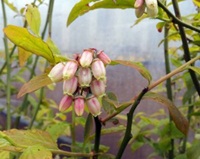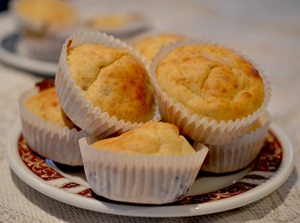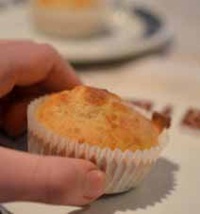

Blueberries are full of nutrients and are easy plants to grow in containers, making them ideal if you’re new to growing food or thinking of getting back into it again. But why would you bother? This article looks at the health benefits of these tiny fruit, explains how to grow your own blueberries in containers and finishes with a healthy recipe for fat-free, sugar-free muffin style blueberry buns that contain just 52 calories each. Read on if you’re tempted to try growing your own this year.
Healthy Blueberry Living

Blueberry, Strawberry & Blackberry Salad with Amoretto Cream from The Step House, Borris
A handful of blueberries carry about a quarter of our daily Vitamin C, are low in fat, packed full of antioxidants (good for protecting against cancer, memory loss and poor circulation) and they contain lots of fibre. They can be eaten raw, cooked or juiced and there’s nothing better than picking your own from mid summer to mid autumn from a fruit bush you’ve grown and tended. They can also be a bit pricey in the shops so what better reason to have some to hand.
Although US biased in terms of production, here’s an infograph from the US Blueberry Council that shares more information about the benefits to your body when you pop a blueberry into your mouth:

Photo courtesy: http://www.blueberrycouncil.org/
How to Grow Your Own Blueberries in Containers

The pink flowers before they turn into the blue berries
Blueberries can grow large in a garden environment – up to 2m in height and spread and need acidic growing conditions in soil of 4.5 – 5.5 pH. However, growing blueberries in containers will keep them in check and as you’ll be supplying them with the correct compost, will cut the need for trying to change the pH of your garden soil.
Kit List for growing blueberries:
- *Two or more plant containers, at least 30 cm or 12″ in diameter each
- Bag of Ericaceous compost (lime hating compost readily available in garden centres)
- Broken pieces of crockery ‘crocks’ or washed gravel
- Rainwater
- *Two or more blueberry plants of different cultivars (varieties)
* Plant two or more different blueberry plants for this project. Blueberries are unusual in that they like to grow alongside other blueberry plants that are slightly different. They tend to crop more heavily when they have companions from different cultivars, so check the labels when you’re buying your plants and avoid buying two the same.
Method:
1. Make sure the containers are clean and dry and that there are holes in the bottom for drainage. Place a few crocks in the bottom of the container over the drainage holes. This stops the soil blocking the holes at a later stage.
2. Put some ericaceous compost in the bottom of the container, remove the blueberry plant from its garden centre container and place on top of the new compost.
3. Fill in the rest of the container with the compost to the same level on the plant as it was in its original container, until the compost is about 5cm from the top of the pot. Any higher and it will overflow when you water.
4. Pack the compost down firmly around the plant, but not too firmly that there’s no air in it. Using rainwater, water the blueberry plant in, aiming the nozzle of the watering cane around the neck of the plant and not sprinkling it all over, until the water runs through and out of the base of the container.
5. Place the containers in a spot that will see the sun for as long as possible which will help to sweeten the fruit and prevent disease.
If you’d like more guidance on growing food in containers, take a look at the article here here for more information.
Watering Blueberries

Blueberries like to be moist but not swimming in water so you’ll have to water them regularly, preferably with rain water, and make sure they can drain adequately. If you are thinking of installing simple rain butts off your roof guttering, now would be a great time. Alternatively, keep a container nearby that you can collect rainwater in. Tap water can contain lots of lime, something that blueberries dislike.
Pruning and Maintenance of Blueberries
Blueberries need very little looking after. If you like to feed your plants, do so monthly from springtime by adding an ericaceous liquid fertiliser (available from garden centres) and they don’t need a lot of pruning.
Let the blueberry bushes to do their own thing for the first couple of years then from the third year onwards, between late February to the beginning of March, remove some of the old wood with a sharp pair of secateurs (you’ll notice the colour change on the branches of the plants from old to new wood).
As the blueberries grow and look like they’re getting too big for their containers, you will need to change their pots for larger ones, at least 45-50cm (18-20in) in size.
Note that it’s unlikely you will see fruit on your blueberry bushes for the first couple of years, longer if they’re in an exposed or shaded area.
Blueberry Pests and Diseases

Birds are the biggest problem as they’ll steal all your berries before you get a look in. If you notice this is a problem, birds could well be the culprit. To prevent them stealing your fruit, drape some netting all around the fruit bushes to prevent birds stealing them but do make sure there are no gaps that they can get caught up in.
Blueberries aren’t prone to disease though might succumb to powdery mildew if it’s particularly dry and the plants have become stressed as a result. If you spot a powdery looking substance on your plant, remove the affected leaves and make sure the plants don’t dry out.
Aphids can be a problem too. Read here for more information about these little greenfly.
Cooking with Blueberries
Blueberries are in season in Ireland from July to September and imported the rest of the year. They’re tasty eaten raw and often added to desserts or smoothies. If you’d like to make a quick breakfast smoothie, add 100g (a cup) of blueberries and 125g (half a cup) of organic yogurt to a blender before whizzing together and emptying into a glass for a healthy start to the day.

No Fat, No Sugar Blueberry & Banana Muffin Style Bun Recipe
I mentioned in an earlier post that Mr G and I have reduced our calories but I’ve found myself missing being able to bake. A fat and sugar-free recipe from the Hairy Dieters cook book caught my attention recently for Banana and Sultana Muffins which I’ve adapted to include blueberries, a fruit that Irish growers Keelings, are currently enticing us with in Irish shops.
Ingredients:

Makes 24 cupcake sized buns or 12 large muffins
250g self-raising flour
1 tsp bicarbonate of soda (baking soda)
2 very ripe bananas (200g peeled)
250ml semi-skinned milk
3 free range egg whites
100g blueberries
½ teaspoon vanilla extract
Method
- Preheat the oven to 210ºC (Gas 6½) and line muffin or cake tins with paper cases.
- Sift the flour and bicarb together in a large bowl. In a separate bowl mash the bananas until smooth then add and mix the milk to the mixture and the vanilla extract. Empty the banana mixture into the flour bowl and mix until fully combined.
- Whisk the egg whites in a clean bowl until they form stiff peaks and lightly fold these into the flour and banana mixture. Add the blueberries and quickly but carefully mix them until evenly distributed.
- Pour the muffin/cake mix into the paper cases and cook in the oven for about 20 minutes.
- When they’re firm, browned nicely and cooked through, remove the buns from the oven and place onto a wire tray to cool. Store them in an airtight container and eat within 2 days.
The Verdict

Our children didn’t notice the fat and sugar were missing, only that the cake stuck to the paper cases, a problem that might be solved by wiping a small amount of oil around the inside of silicon bun cases. They loved the blueberry flavour best of all.
The little buns certainly left me feeling that I’d eaten cake and my thoughts are that a couple of these with low-fat custard would make a tasty dessert.
Nutrition Facts (per muffin cake): Calories 52, Fat 0.4g, Carbs 10.3g, Protein 2g
What do you think? Will you take up the challenge and grow blueberries this year or are you already growing and harvesting your own?

Dee Sewell – a horticulturalist and certified trainer who started Greenside Up in 2009 and teaches people how to grow vegetables. Dee specialises in working with community gardens but also offers workshops, allotment visits, consultations, horticultural therapy, afterschools clubs as well as local talks – she tailors her services to meet clients needs. In 2012 Dee launched a Seed Gift Collection containing varieties of vegetable and insect friendly flowers with the aim of getting more people growing. Dee’s blog was a finalist in the 2012 Ireland Blog Awards in the Eco/Green and Lifestyle Categories.
Source: GreensideUp – From Bush to Bun – Growing & Baking Blueberries – Dee Sewell






